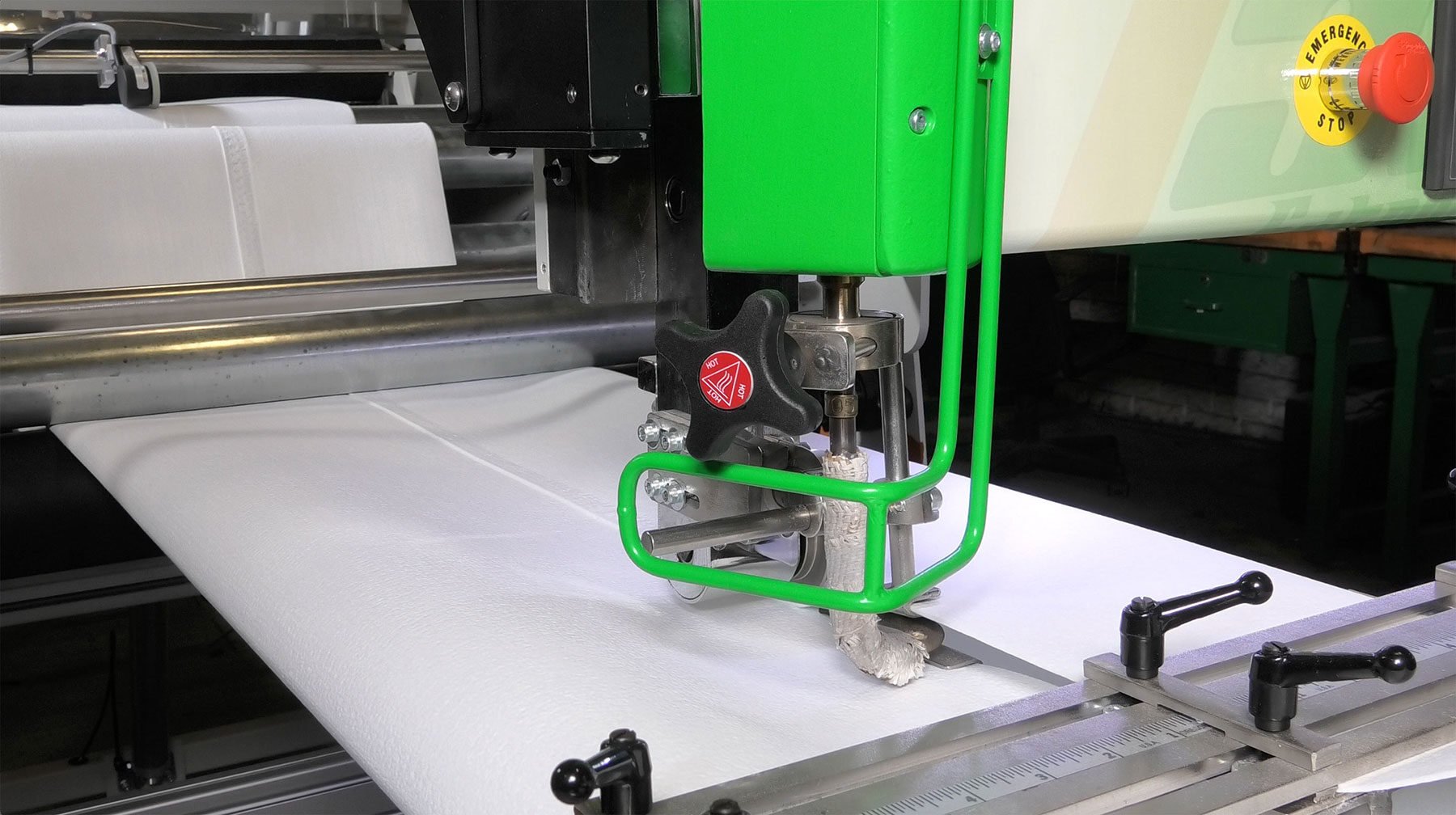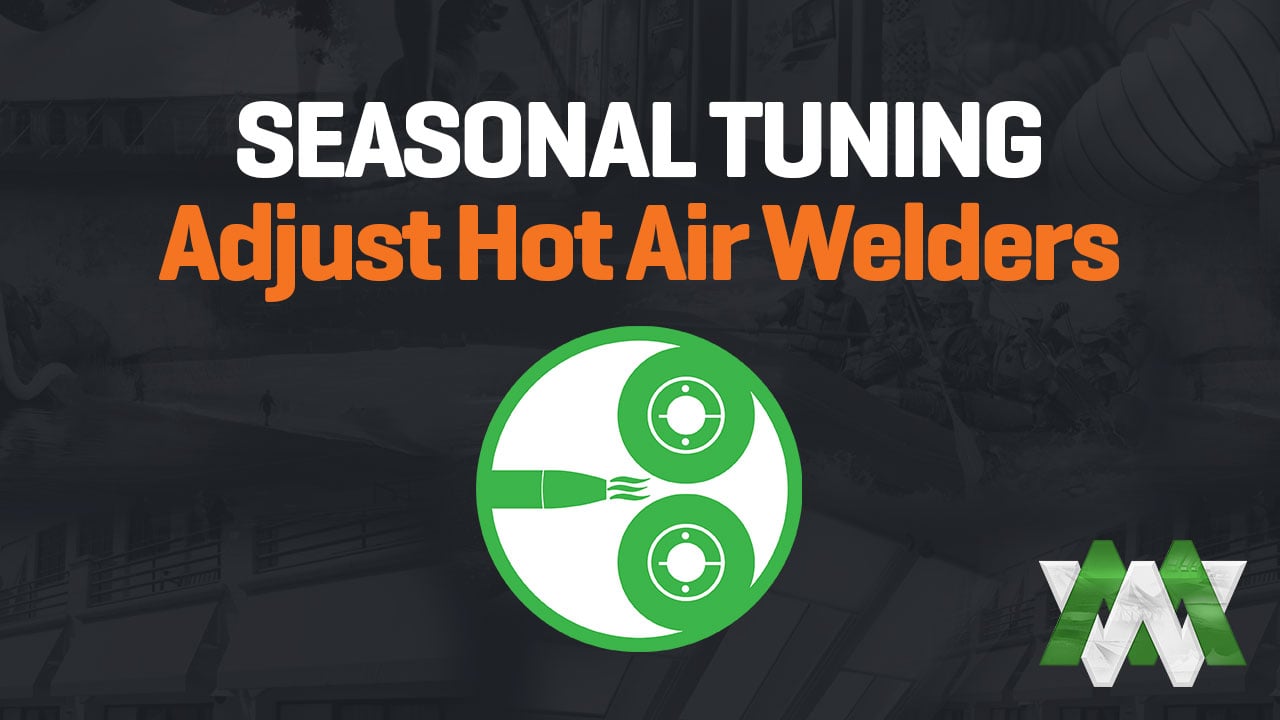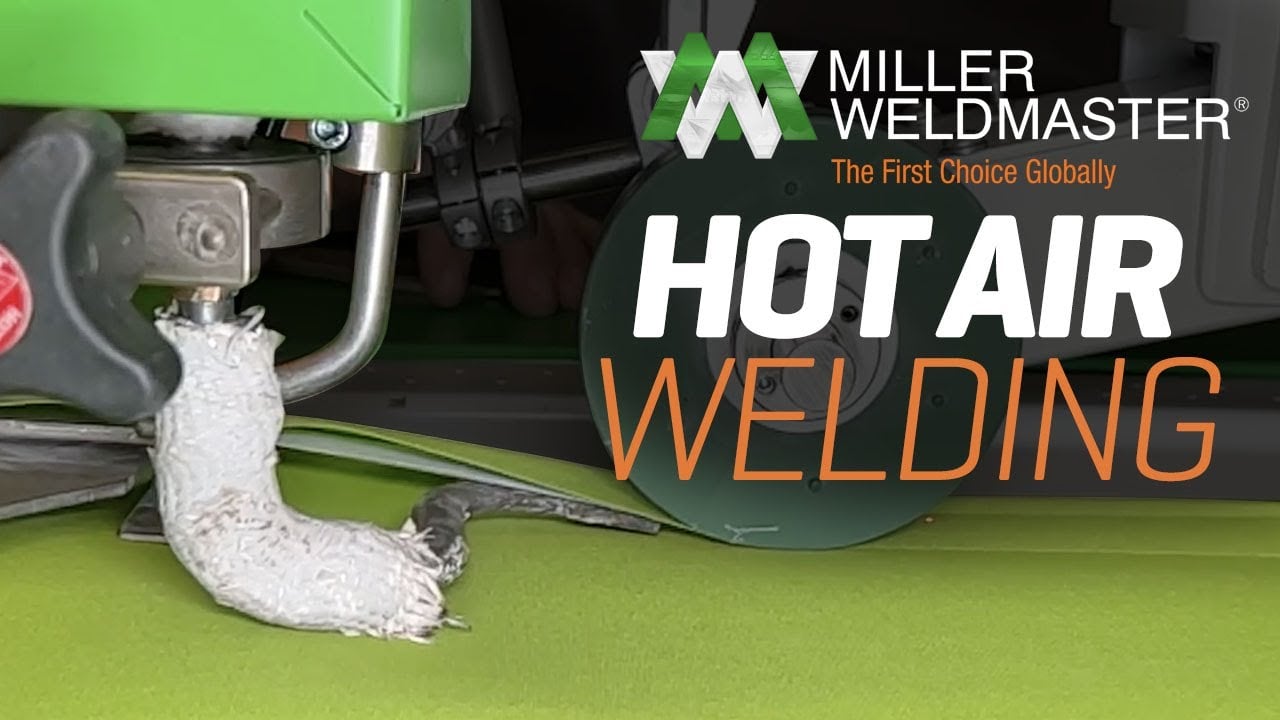In today’s world of industrial fabric welding, choosing the right equipment can mean the difference between producing strong, durable products or struggling with subpar results. It is essential to determine the type of plastic material before choosing a hot air welder. Hot air welding machines are essential tools for industries working with thermoplastics, vinyl, coated textiles, and more. Whether you’re welding PVC banners, manufacturing inflatables, or sealing tarps, understanding how to choose a hot air welder is crucial for long-term success.
In this guide, we’ll walk you through everything you need to know about hot air welding: from how it works to common applications, key considerations for buying a machine, and why Miller Weldmaster is the trusted name in industrial hot air welders. Learn more about hot air welding technology here.
What Is Hot Air Welding and How Does It Work?
Hot air welding, also called heat sealing, is a thermoplastic bonding process that uses precisely controlled heat, speed, and pressure to fuse materials together without adhesives or solvents. A hot air welder blows a stream of heated air between the surfaces to be joined, softening them just enough to bond when pressed together by rollers or mechanical force. In this process, a welding rod is often used to fill a V-groove, ensuring a strong fusion between the thermoplastics. This method creates clean, durable, and weather-resistant seams, ideal for industrial applications where reliability is critical. Hot air welding is preferred because it produces strong, consistent seams while maintaining the material’s flexibility and original properties.
Key Components of Hot Air Welding Machines
Hot air welding machines consist of several vital components working together. Compressed air plays a crucial role in generating heat and applying pressure to join thermoplastic materials. The heating element generates the necessary hot air to soften the thermoplastic materials. The nozzle directs the hot air precisely to the welding zone, ensuring targeted heating. The drive system moves the machine automatically along the material for consistent seam quality, while the pressure rollers press the softened materials together to create a permanent bond. Machines also feature variable controls that allow operators to adjust temperature, speed, and pressure based on the specific material being welded, ensuring precise and durable results.
Materials Compatible with Hot Air Welding
Hot air welding is suitable for a wide range of thermoplastics, including polyvinyl chloride (PVC), polyethylene (PE), polypropylene (PP), and polyurethane (PU). It is crucial to match the filler rod to the base material to ensure the success of the welding process. These materials respond well to controlled heat and pressure, making them ideal candidates for hot air fusion. Additionally, hot air welding is commonly used on multilayer fabrics and coated textiles found in industrial and commercial applications.
Common Applications of Hot Air Welders Across Industries
Hot air welding machines serve multiple industries where high seam strength, durability, and precision are critical. Proper installation techniques for thermoplastic single-ply roofs, particularly through effective hot-air welding of seams and laps, are essential for ensuring optimal roof performance.
Banners, Billboards, and Signs
In the signage industry, hot air welders are essential for creating flawless visual presentations. They help achieve professional results by ensuring high-quality seams that are both strong and visually appealing. They produce strong overlap seams with minimal visual disruption, resulting in a professional and seamless appearance. Additionally, hot air welded seams provide excellent weather resistance, ensuring that outdoor advertising materials like billboards and banners remain durable and intact even under harsh environmental conditions.
Tarps, Tents, and Awnings
For tarps, tents, and awnings, hot air welding offers the strength, UV resistance, and flexibility needed to meet demanding outdoor performance standards. Detail work is essential in ensuring weld consistency for these applications, as it directly affects safety, longevity, and user satisfaction. Properly welded seams extend the lifespan of products exposed to constant environmental wear and tear.
Inflatables and Specialty Products
When manufacturing inflatables, precision air retention and complex seam sealing are paramount. Hot air welding ensures airtight, reliable seams that can withstand significant stress and pressure. Selecting the appropriate filler material that matches the base plastic is crucial for ensuring these airtight, reliable seams. The method accommodates various seam types, such as overlap, hem, and flange seams, allowing manufacturers to meet the diverse design and functional requirements of inflatable products like bounce houses, inflatable boats, and advertising structures.
How to Choose a Hot Air Welder for Your Application
Selecting the right industrial hot air welder depends on your specific production needs, material types, and end-product requirements. Understanding the welding process is crucial, as precise control over temperature, speed, and pressure is essential for achieving strong and reliable joints in roofing applications.
Consider Your Materials and Fabric Types
Different thermoplastics respond differently to heat, making material compatibility a critical factor when choosing a hot air welder. During the welding process, the welding rod and plastic base material are melted together to achieve effective adhesion and repair. For instance, PVC welding machines require precise temperature control to avoid damaging the material, while polyurethane fabrics may need a slightly different heat profile for optimal bonding. Choosing a machine tailored to your material type ensures strong welds and extends product life.
Evaluate Seam Types and Welding Techniques
It is important to consider the types of seams your production demands. Selecting the appropriate rod for different seam types is crucial for a successful plastic welding process. Overlap seams are commonly used for large surface areas like tarps and banners, while hem welds provide reinforced edges that enhance strength and durability. Flanged seams are essential for inflatables where airtightness is critical. Selecting a machine that supports all necessary seam configurations will maximize production versatility.
Assess Your Production Volume and Workflow Needs
Your production volume will significantly influence the type of machine you need. Efficiently managing production volume is crucial to ensure consistent quality. Smaller shops with low-volume production may benefit from compact, manual tabletop models that are easier to manage and maintain. In contrast, facilities focused on high-volume output should consider investing in fully automated hot air welders that maximize throughput and ensure consistent quality across large production runs. Planning for scalability can help you avoid future upgrade costs as your production demands grow.
Hot Air Welders from Miller Weldmaster: Solutions for Any Industry
At Miller Weldmaster, we’ve built a reputation over 50 years for innovation, reliability, and industry leadership in hot air welding machines. Using nitrogen gas as a shielding gas in our modern welding techniques for thermoplastics helps eliminate oxygen from the weld area, resulting in cleaner, contaminant-free welds. Our solutions are trusted worldwide for quality and performance.
T300 Extreme Flex: Versatile Welding for Diverse Materials
The T300 Extreme Flex is a versatile powerhouse designed to handle a wide range of material types, including PVC, PE, PU, and multilayer textiles. It excels in plastic welding, making it suitable for various materials and applications. It supports various seam configurations and is built for medium to high production environments where flexibility, speed, and consistency are paramount. Its intuitive controls and modular options make it a favorite among industries needing a robust yet adaptable welding solution.
T3 Extreme: Compact and Efficient for Graphics and Signage
The T3 Extreme is an excellent choice for businesses specializing in signage, banners, and graphic displays. This model stands out among heat guns for its adjustable temperature settings and specialized attachments, making it suitable for tasks like welding, crafting, and stripping paint. It features a user-friendly interface that simplifies operation, a compact footprint ideal for space-limited shops, and the ability to produce professional-quality seams with precision. Its efficiency and affordability make it a top option for companies entering the world of hot air welding.
Backed by Industry Experts and Support
Miller Weldmaster goes beyond just selling machines. We pride ourselves on delivering lifetime value through expert training, responsive technical support, and customized machine solutions. Using the proper equipment and support is crucial to ensuring that items are repaired successfully. Our dedication to customer success has made us a preferred partner for companies looking for reliable, high-performance industrial fabric welding solutions.
When it comes to how to choose a hot air welder, understanding your application needs, material compatibility, production goals, and seam types are critical. Whether you’re welding vinyl banners, industrial tarps, or inflatable seams, investing in the right equipment—and the right partner—makes all the difference.
Ready to elevate your production? Explore our full range of hot air welders and see why Miller Weldmaster is the trusted name for industrial fabric welding solutions. Learn more about our technology here.
Frequently Asked Questions About Choosing and Using a Hot Air Welder
What is the difference between hot air welding and hot wedge welding?
While both techniques involve heating thermoplastic materials for bonding, hot air welding uses a stream of heated air to soften surfaces, whereas hot wedge welding employs a heated metal wedge to accomplish the same task. Hot wedge welding is often used for very thick or heavy materials where faster welding speeds are beneficial, while hot air welding offers greater flexibility for various material types and seam designs.
Can hot air welders be used on all types of thermoplastics?
Hot air welders are highly versatile but are not suitable for all plastics. They work best with materials such as PVC, PE, PP, and PU. Before beginning a project, always verify that your material is compatible with hot air welding techniques to ensure proper adhesion and seam strength.
How do I know which seam type is right for my application?
The choice of seam type depends heavily on the final product’s intended use. Overlap seams are ideal for joining large surface areas securely, hem welds provide added strength and a clean finish to edges, and flanged seams are critical for creating airtight or watertight products like inflatables. Understanding your product requirements will guide you to the correct seam style.
What maintenance does a hot air welder require?
Proper maintenance is essential for preserving the lifespan and performance of your machine. Regularly cleaning the nozzle prevents material buildup, inspecting and replacing worn rollers ensures consistent pressure, and checking the heating element for wear maintains temperature accuracy. Following a proactive maintenance schedule can significantly reduce downtime and repair costs.
Are hot air welders safe and easy to operate?
Modern hot air welders are designed with operator safety and ease of use in mind. They feature intuitive controls, automated temperature and speed settings, and integrated safety mechanisms such as heat guards and emergency stop functions. With proper training, even new operators can quickly achieve high-quality welds safely and efficiently.
How long does a typical weld last?
When properly executed, a hot air weld can last the lifetime of the product. Welds created through hot air welding resist weathering, mechanical stress, and aging, maintaining their integrity even under challenging environmental conditions.
What industries benefit most from hot air welding?
Industries that benefit significantly from hot air welding include signage and graphics, tarp and cover manufacturing, tent and structure production, inflatable manufacturing, and industrial textile fabrication. These industries rely on durable, flexible, and waterproof seams for product performance and safety.
Do I need training to operate a hot air welder?
Although many hot air welders are user-friendly, formal training is highly recommended. Proper training ensures that operators understand material handling, seam techniques, and machine maintenance, leading to better weld quality and extended equipment lifespan. Miller Weldmaster provides comprehensive training programs for all customers.
What should I look for in a reliable welding machine brand?
When selecting a welding machine brand, consider the company's reputation for quality, the availability of strong warranties and responsive customer support, the versatility of machine options, and the provision of educational and maintenance resources. Miller Weldmaster meets all these criteria, offering machines that customers can trust for years of reliable service.
Can one hot air welder handle multiple materials and seam types?
Advanced machines such as the T300 Extreme Flex are engineered to handle multiple materials and accommodate various seam types with ease. With modular attachments, adjustable settings, and versatile nozzles, a single high-quality machine can serve a broad range of production needs, increasing efficiency and reducing operational costs.





